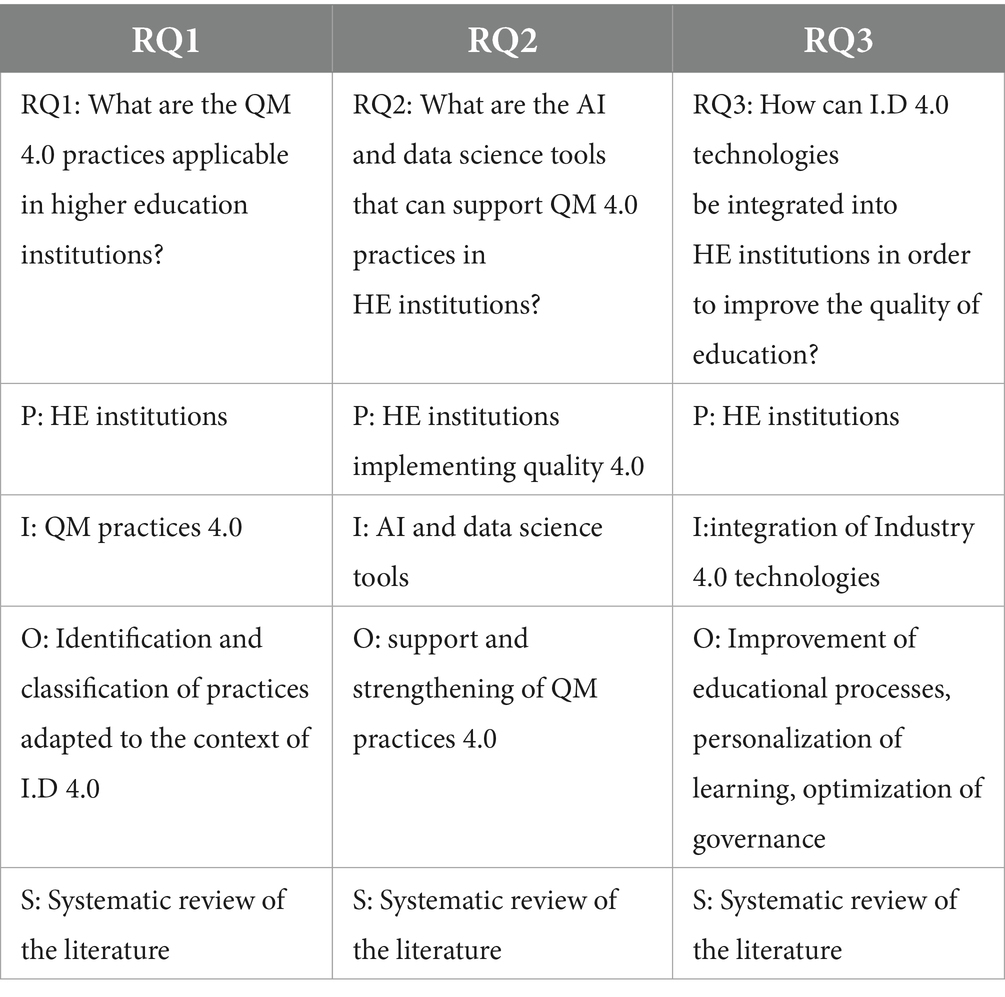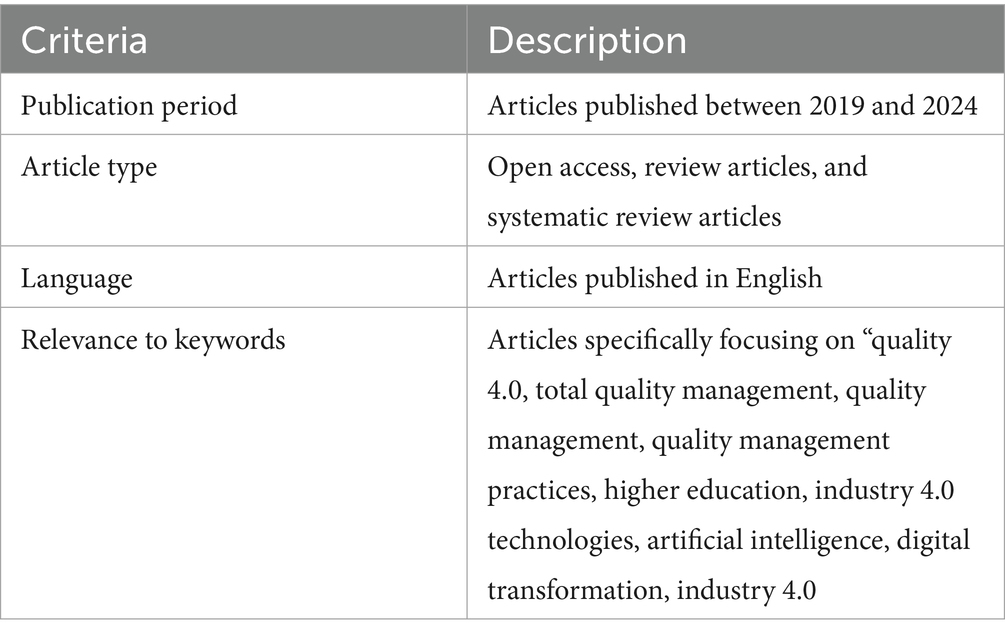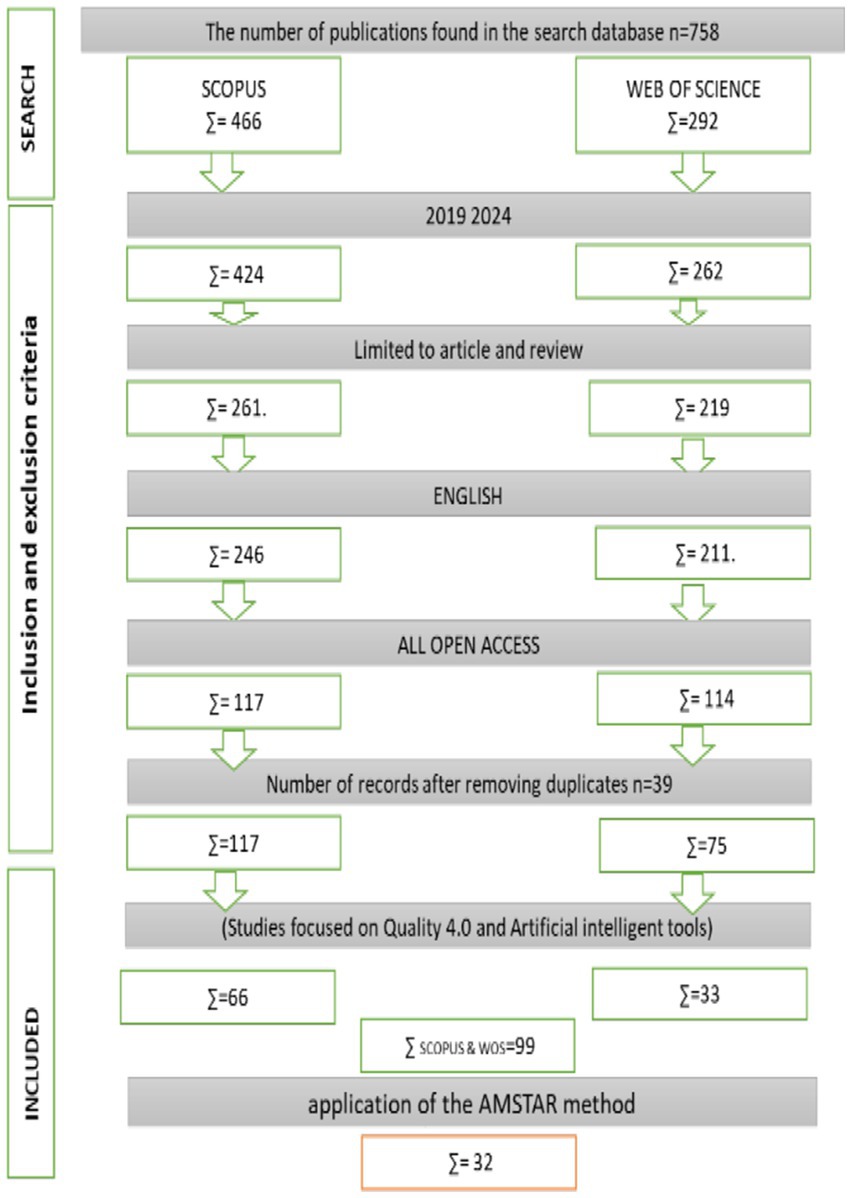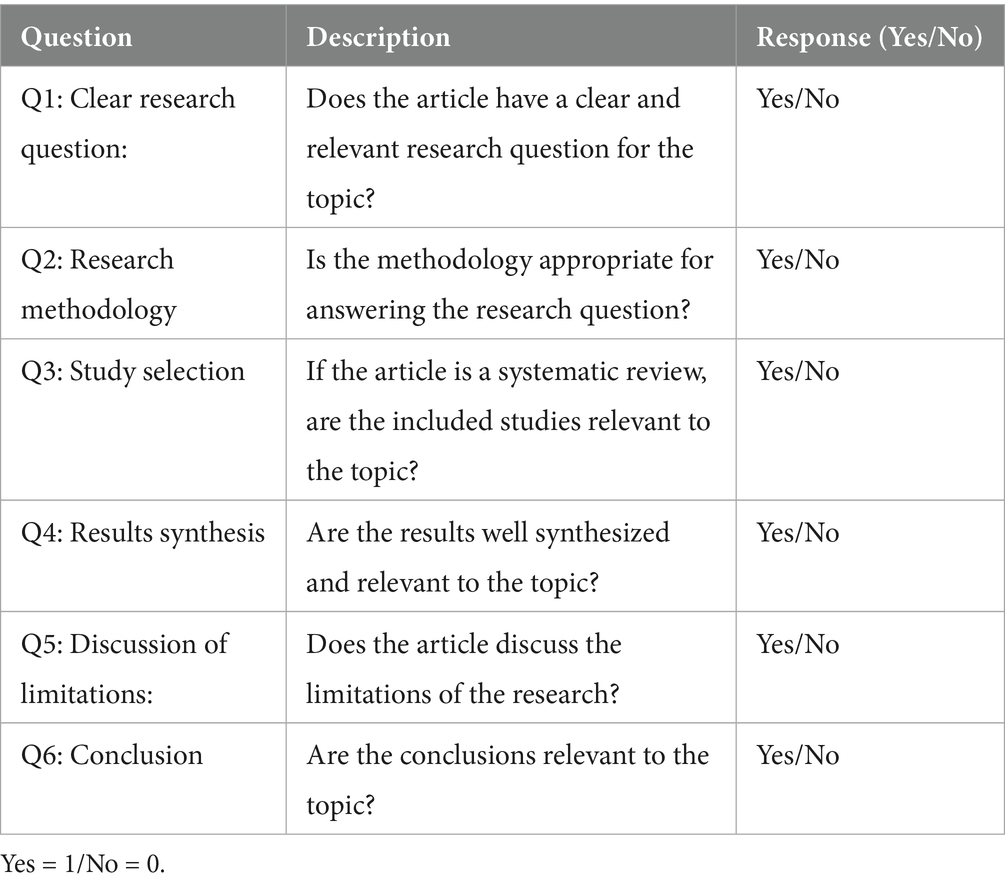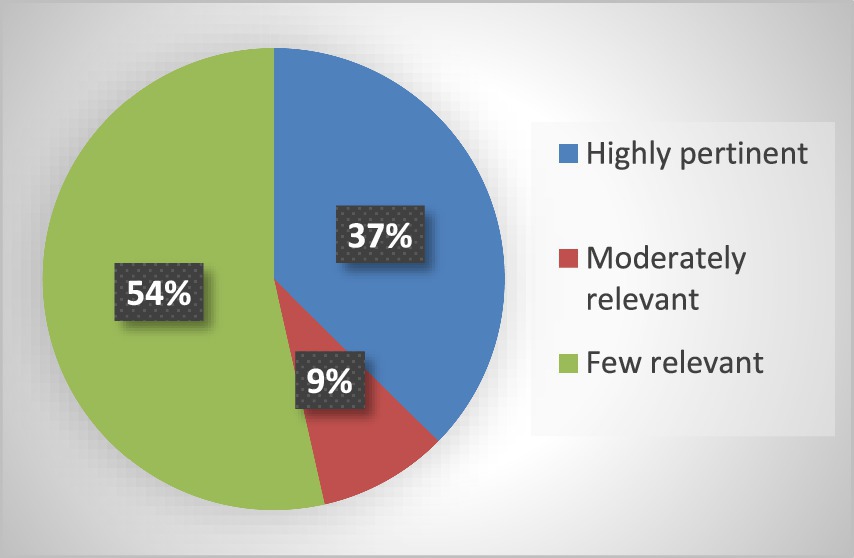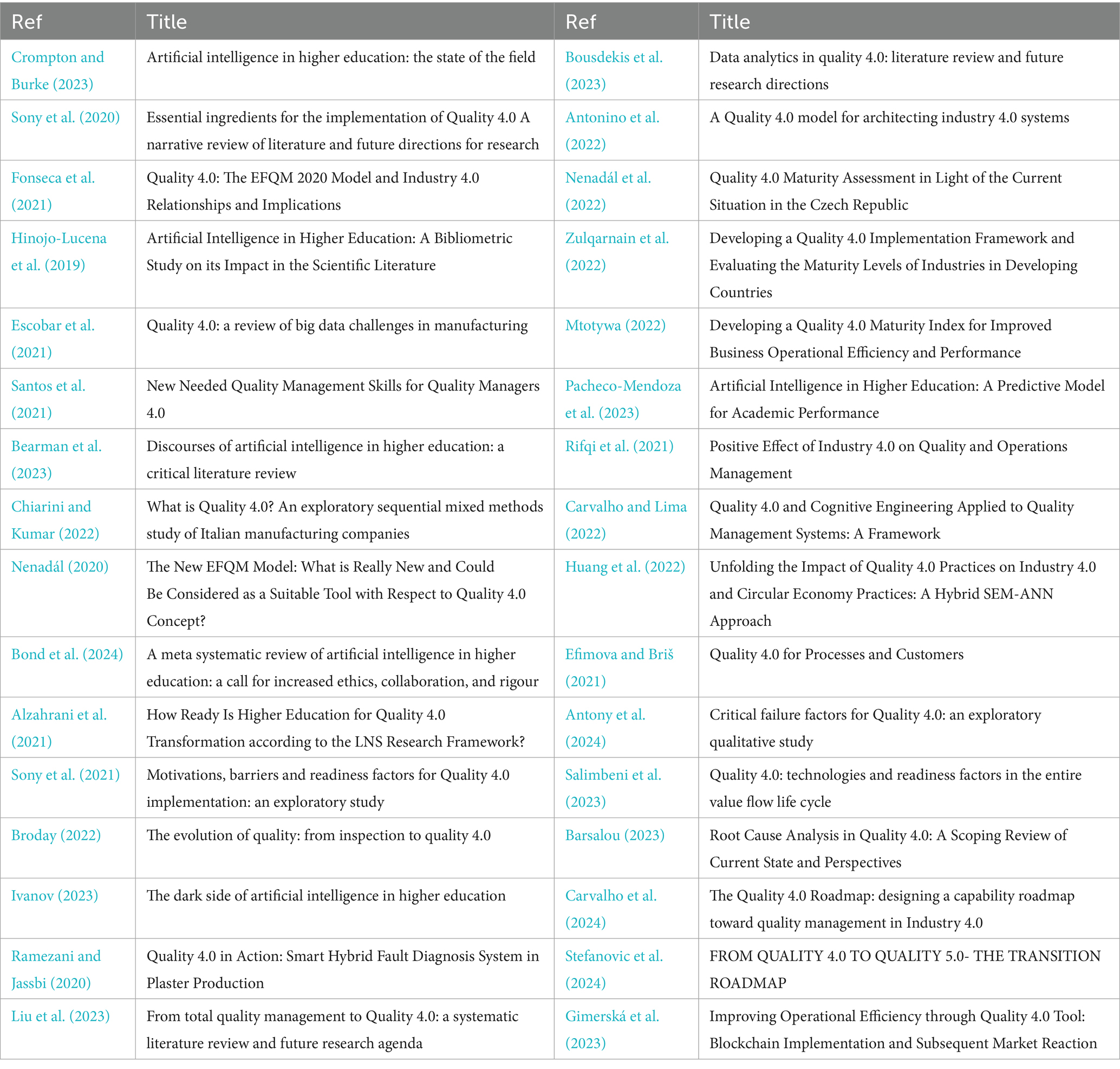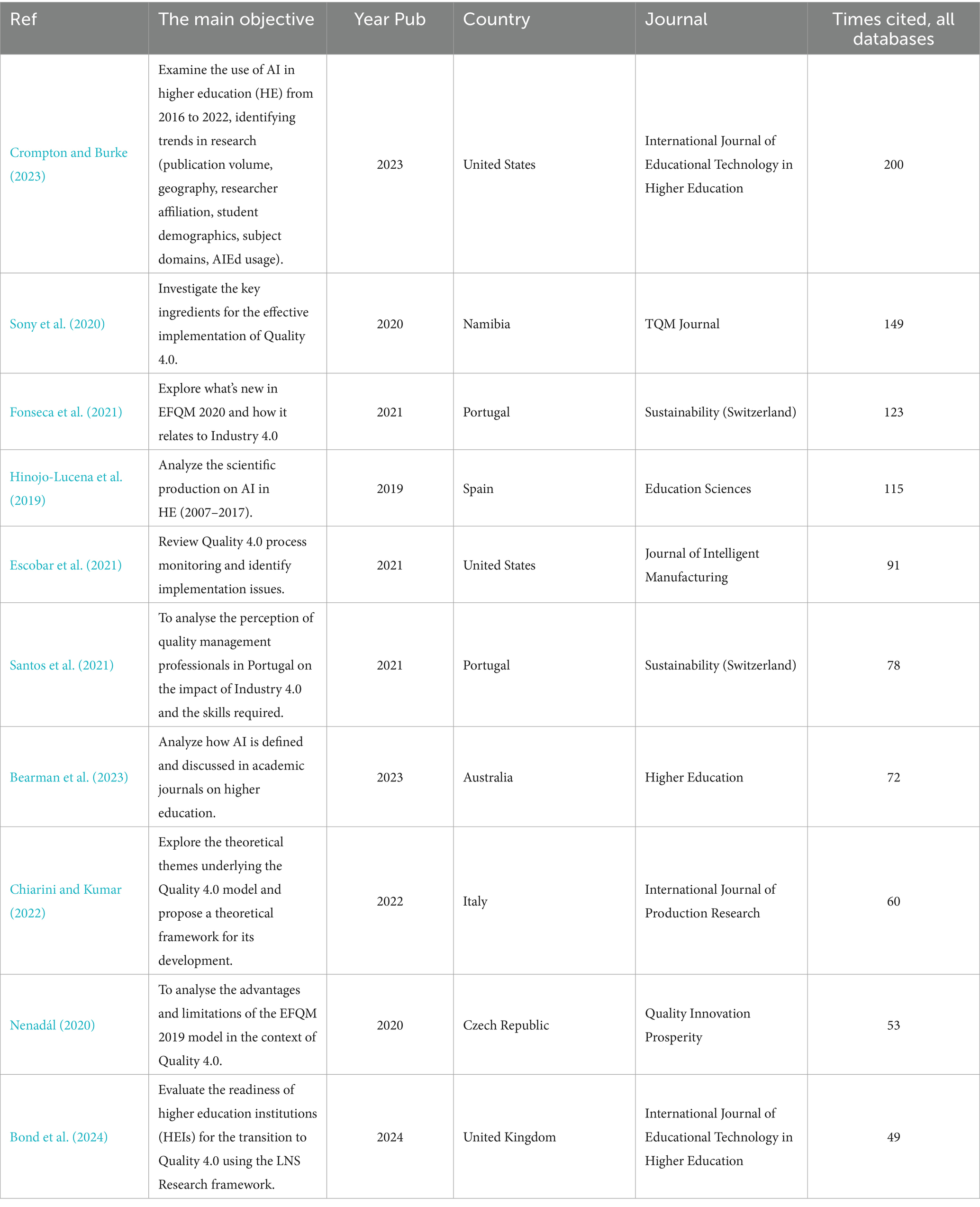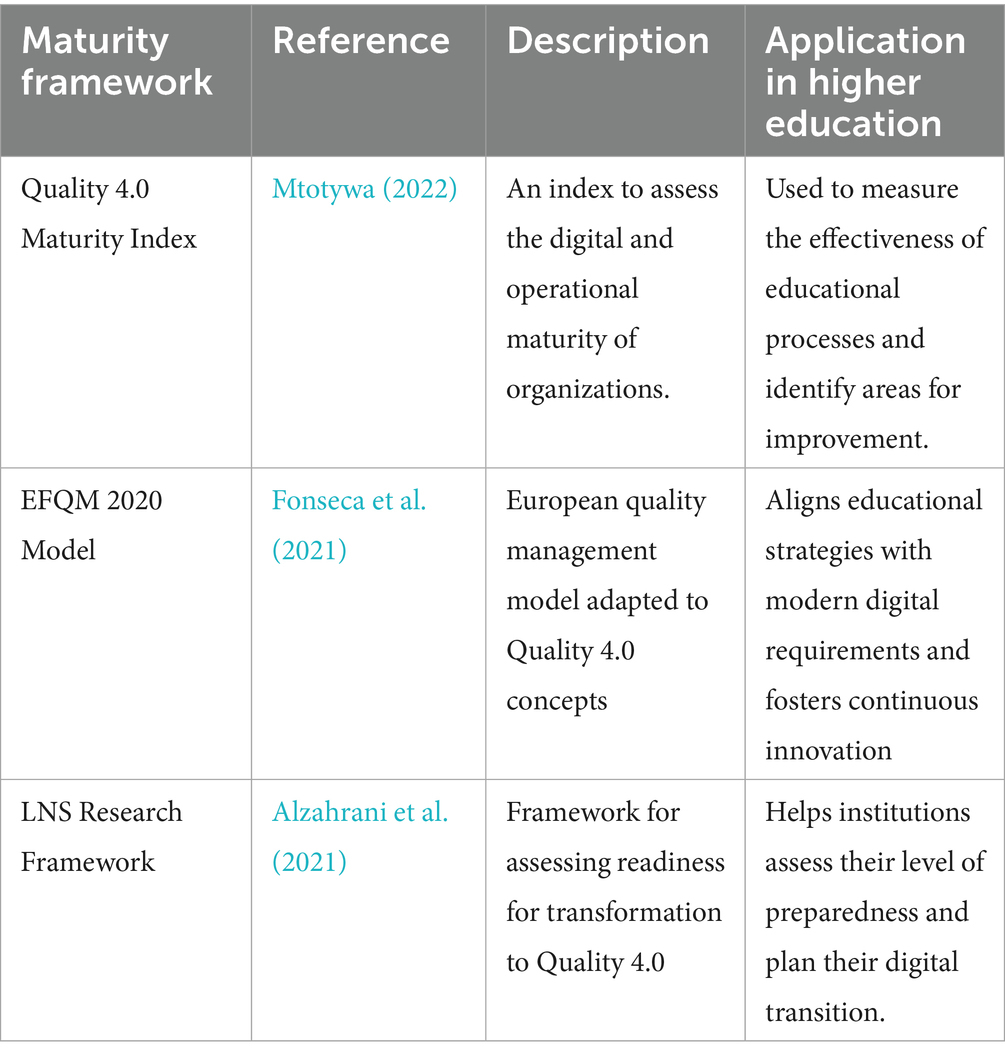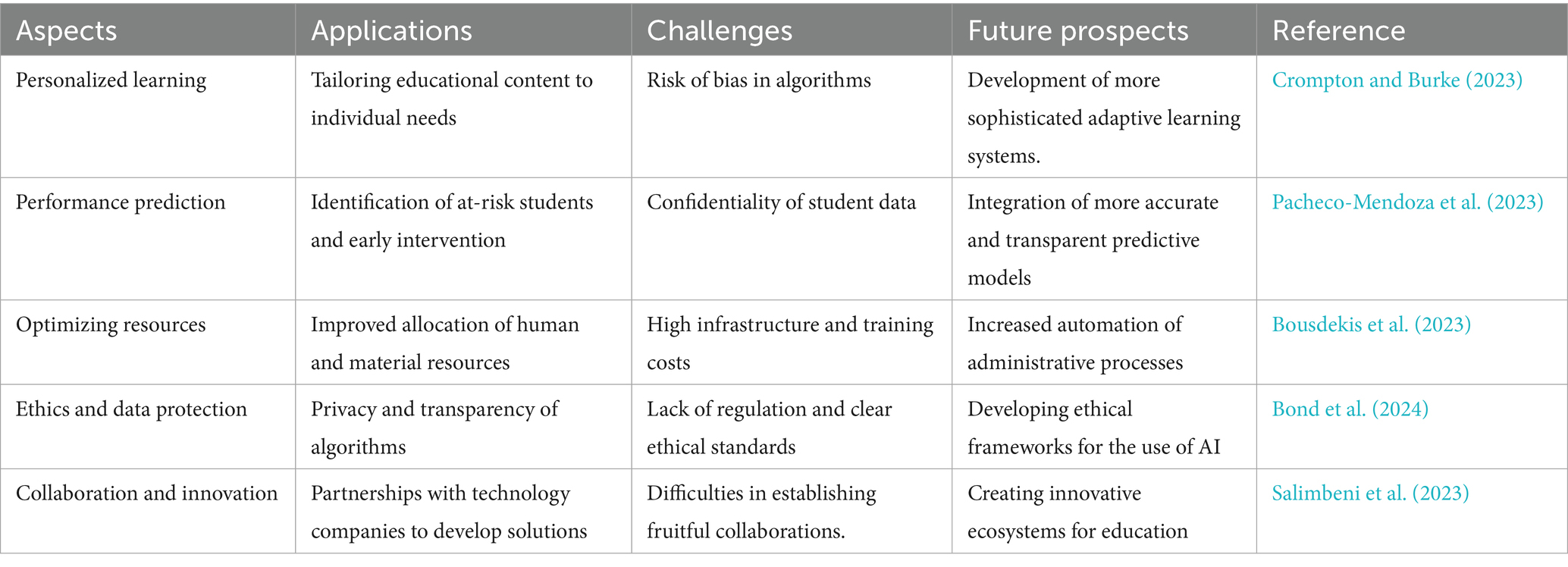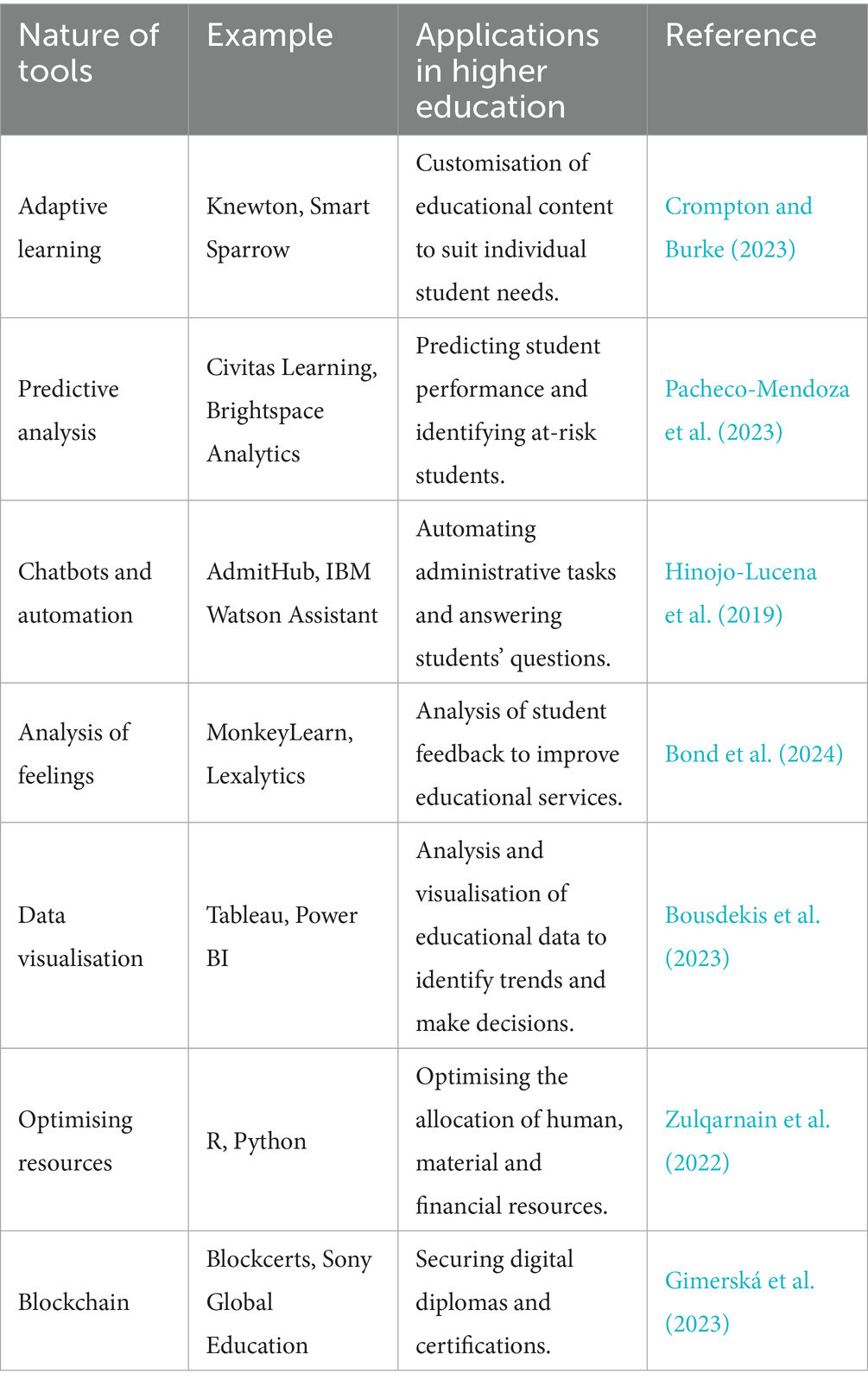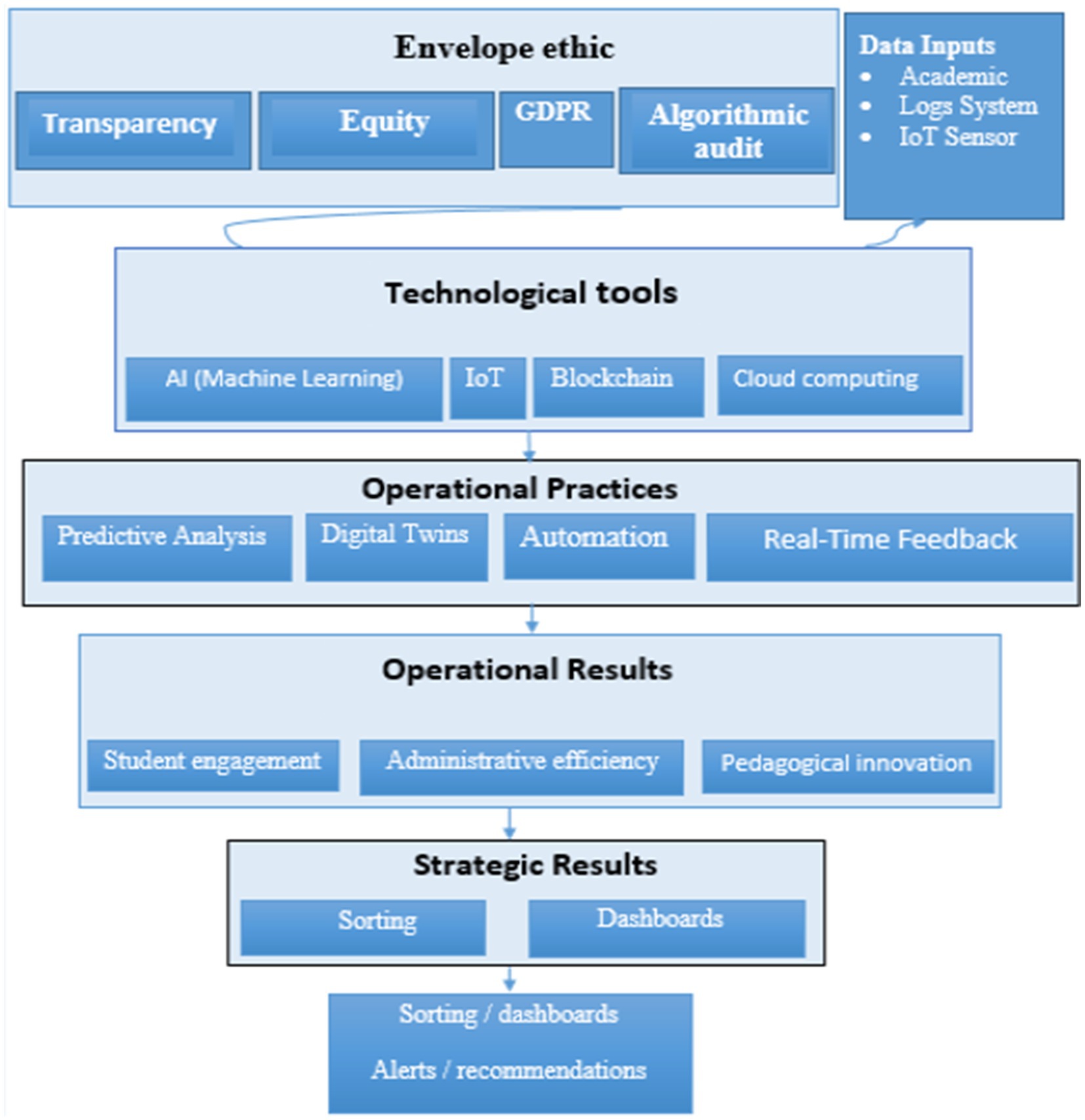- Laboratory of Modeling and Simulation of Intelligent Industrial Systems, ENSET, Hassan II, University of Casablanca, Casablanca, Morocco
Quality management practices play a critical role in higher education, ensuring the reliability and efficiency of educational processes. Today, with the advent of the Higher Education 4.0 era, higher education institution leaders are facing increasing challenges, particularly with regard to the need to ensure quality education to a diverse audience, adapt these practices to the challenges posed by digital technologies and new pedagogical requirements, meet labor market demands, and manage limited financial resources. Just as in Industry 4.0, where the integration of digital technologies is transforming production processes, Higher Education 4.0 aims to rethink education through an integrated digital approach. This article investigates the adaptation of quality management practices to Higher Education 4.0. It explores, through a literature analysis, the integration of emerging technologies like online learning platforms, virtual reality, artificial intelligence, and data analysis into educational processes to enhance the quality of teaching and learning. This study aims to highlight the correlation between quality management practices and Higher Education 4.0 technologies (Industry 4.0 outputs), thus providing a practical framework to guide educational institutions in their transition to a more digital and quality-oriented higher education model.
1 Introduction
In the era of Industry 4.0, higher education institutions are undergoing a profound transformation, driven by the rapid integration of digital technologies and the evolution of pedagogical models. The expectations of students, employers, and stakeholders are becoming increasingly complex, requiring innovative responses in terms of quality management (Miranda et al., 2021; de Oliveira et al., 2023). While previous work has highlighted the lack of operational frameworks suitable for integrating Industry 4.0 technologies into higher education practices (Kerroum et al., 2020), more recent research shows that significant progress has been made. Indeed, the objectives of Industry 4.0 (I.D. 4.0) have directly influenced the content of Education 4.0 (E.D. 4.0), leading to substantial revisions of curricula and the emergence of new models of academic governance.
Thus, the main challenge is no longer just to ensure the compliance or effectiveness of educational processes, but to rethink quality governance in order to respond dynamically to digital transformations, the personalization of learning paths, and intensifying global competition. In a constantly changing environment, maintaining academic excellence depends on developing new quality management strategies that can take advantage of the opportunities offered by artificial intelligence, virtual and augmented reality (VAR), big data analysis (BDA), and blockchain (Baygin et al., 2016).
Recent contributions highlight how the adoption of agile methodologies, AI-based personalization, and immersive technologies are transforming teaching and learning. For example, Chakraborty et al. (2025) show how agile methods have been successfully integrated into the chemical engineering curriculum, Galatro and Chakraborty (2025) also propose frameworks for mapping the interactions between Education 5.0 and Industry 5.0. Similarly, Chakraborty et al. (2025) explore how AI, sustainability, and STEM education can support the broader vision of Society 5.0, and Galatro et al., (2025) present a roadmap to Education 5.0 through practical laboratory case studies. Taken together, these works provide concrete evidence that the transition is now underway not only toward Industry 4.0, but also toward Industry 5.0 and Education 5.0.
In this context, adapting the principles of Quality Management (QM) 4.0 to the field of higher education (HE) appears both feasible and essential. By integrating these approaches in a structured manner, institutions can strengthen the efficiency, productivity and relevance of their programs, while responding more closely to the evolving needs of students, employers and society as a whole. To this end, this study aims to:
• Identify specific Quality 4.0 practices and tools applicable to higher education.
• Propose a practical framework to facilitate their implementation and adaptation to diverse academic contexts.
Thus, this article will highlight how QM can evolve to meet the challenges and issues of HE in the era of ID. 4.0, while providing institutions with a structured roadmap to steer their quality-oriented digital transformation.
Initially, a literature review is conducted to understand the logic behind the formulation of the research questions, in order to better understand and explore the solution of the problems encountered in a quality perspective in HE in this era of ID 4.0.
The originality of this research lies in the need to develop a deep understanding of QM practices in the era of ID.4.0 and their application in HE institutions, thereby addressing the lack of studies on the impact of the growing digital transformation on quality.
The rest of this paper is organized as follows: Section III outlines the research methodology, the following sections explore QM 4.0 practices, analyze specifically these practices in the context of industry and then HE, and examine artificial intelligence (AI) tools that can be applied to the QM 4.0 practices and used in the framework of E.D 4.0. In conclusion, a summary of our research results is presented, accompanied by recommendations for future research.
2 Related works
QM has evolved considerably over time, from basic concepts to complex structured practices, techniques and procedures aimed at improving organizational performance and sustainability (Harvey, 1998). Within HE institutions, it is crucial to adopt effective QM practices in order to differentiate themselves from competitors and ensure long-term sustainability (Papanthymou and Darra, 2017). The transformation of the educational landscape, characterized by rapid technological advances, requires a transition from traditional quality methods to more advanced approaches in line with I.D 4.0, referred to as Quality 4.0.
In the literature, quality has been interpreted in several ways, such as the ability to create value, ensure compliance with requirements, fitness for purpose, and meet or even exceed customer expectations. Al-Tarawneh (2011) assert that quality is an evolutionary process aimed at ensuring the consistency and reliability of results. According to Harvey and Green (1993), quality in educational institutions is not limited to academic programs alone, but also encompasses administrative practices as well as the overall reputation of the organization. In order to maintain their competitive advantage and ensure sustainability, HE institutions have incorporated various traditional QM methods, such as total quality management (TQM), quality function deployment (QFD), and Lean Six Sigma (LSS). These approaches have reduced costs, increased efficiency, streamlined procedures, and improved customer satisfaction (Divya et al., 2024). However, with the rapid advancement of technology, it is necessary to adapt traditional QM practices to meet current standards (Elshennawy, 2004).
The shift to Quality 4.0 is driven by the need to integrate advanced I.D 4.0 technologies, including AI, BDA, the Internet of Things (IoT), and cyber-physical systems, into QM practices. This paradigm shift aims to better align QM with the organization’s overall strategies and strengthen data-driven decision-making. It thus addresses persistent challenges, including a still insufficiently entrenched quality culture and a lack of operational visibility into key processes (Radziwill, 2018). According to Sony et al. (2020), Quality 4.0 enhances traditional quality methods by leveraging digital technologies, enabling real-time data collection, predictive analytics, and proactive maintenance (Chakraborty and Galatro, 2025), further argue that Quality 4.0 provides organizations with the ability to optimize their operational efficiency, raise the quality of their products and services, and strengthen their overall competitiveness, through advanced data monitoring and analysis systems.
In HE institutions, the implementation of Quality 4.0 is essential to prepare generations capable of adapting to technological innovations and acquiring the key skills of the 21st century required by I.D 4.0 (Chakraborty et al., 2023). This study aims to explore QM 4.0 practices in HE, identify tools that can support these practices, and assess the integration of I.D 4.0 technologies to improve the quality of education. By providing a clear conceptual framework, this research will help decision-makers effectively engage in this essential transition.
3 Research methodology
This study is based on a systematic literature review designed to examine the integration of Quality 4.0 practices in the field of HE. It facilitates the identification of gaps in the current literature and the establishment of avenues for future work, while ensuring the rigor, transparency and reproducibility of the scientific approach (Kitchenham, 2007).
3.1 Structuring of research questions according to the PICOS framework
To structure the research questions, the PICOS (Population, Intervention, Comparison, Outcomes, Study design) (Amir-Behghadami and Janati, 2020) framework was used to ensure clarity and transparency of the methodology followed. As shown in Table 1.
Thus, in general, and following the adoption of the PICOS framework, which ensures compliance with the standards of systematic reviews, and offers a clear and synthetic vision of our approach, the target audience includes HE institutions, while the interventions studied focus on the adoption of QM 4.0 practices, AI tools or the integration of I.D 4.0 technologies. The expected results concern the potential for improving quality practices and institutional performance. Finally, the study is designed on the basis of a systematic review of the literature, without any direct comparative intervention, which justifies the absence of a “comparative” element in the PICOS system.
3.2 Definition of the research protocol
In order to answer these questions, a literature review was undertaken by consulting two renowned academic databases, Scopus and Web of Science. These databases were selected due to their comprehensiveness and multidisciplinary coverage, thus providing access to high-quality articles in the fields of quality management, education, and emerging technologies. A further exploration of the ERIC and IEEE Xplore databases is planned for future work to expand the educational and technological scope of the review. The objective of this article is to conduct a comprehensive study based on recent article published in the last 6 years (2019–2024).
The research focused exclusively on original articles and literature reviews, applying an iterative process aimed at optimizing the relevance of the selected documents. Table 2 summarizes the keywords used for the search, as well as the inclusion and exclusion criteria used.
3.3 Study selection process
After an initial search in the Scopus and Web of Science databases, 466 and 292 articles were identified, respectively. Following a filtering process based on the publication period (2019–2024), document type (articles and reviews), language (English), and open access availability, 117 records from Scopus and 114 from WoS were retained. After removing 39 duplicates, 117 articles from Scopus and 75 from WoS remained. Titles and abstracts were then screened to ensure alignment with the research objective, specifically studies focused on Quality 4.0 and artificial intelligence tools. This led to the selection of 99 articles. Subsequently, the methodological quality of these studies was assessed using the AMSTAR checklist. Based on this evaluation, 32 articles were finally included in the review, as illustrated in Figure 1. The entire selection process was conducted by the first author of this study.
3.4 Assessment of the quality of studies
To verify the quality of the articles included in this study, we selected certain items from the AMSTAR Method (Shea et al., 2007), which typically includes 11 questions designed to assess the quality of health studies as part of a self-assessment. In our case, only six items adapted to the field of education were retained and applied to the 99 articles meeting the inclusion and exclusion criteria. These six items are presented in Table 3. Each article was assessed according to these criteria, with two possible answers for each item: “yes” (value 1) or “no” (value 0).
Following this assessment, Figure 2 shows that 32 articles were considered highly relevant (37%), 14 were considered moderately relevant (9%), and 53 were considered low relevant (54%).
Following this assessment, the 32 articles deemed highly relevant were selected for in-depth analysis and inclusion in this study, consistent with the research questions and objectives.
This systematic review was conducted in accordance with the Preferred Reporting Items for Systematic Reviews and Meta-Analyses (PRISMA) guidelines to ensure quality, transparency, and methodological rigor. The study selection process is presented in the form of a PRISMA flowchart detailing each step, including reasons for exclusion. A completed PRISMA checklist is attached as an appendix to demonstrate full compliance of this review with international best practices.
3.5 Data extraction and synthesis
In order to answer the research questions, another excel database was created for the 32 articles, containing general information such as the title of the study, authors, year of publication and place of publication, it also contains specific information that directly addresses the research questions, such as the area of interest, the main objectives of the study, the identified I.D 4.0 technologies or AI tools used, the results obtained and its relationship with quality 4.0 and education, the limitations of the research and the citation. The 32 selected articles are presented in Table 4.
4 Results and discussion
This section is divided into two subsections: the first provides a general description of the results from the analysis of the 32 selected articles, while the second presents an in-depth analysis addressing the pre-established research questions.
4.1 Overall description
Figure 3 illustrates the number of data summaries published per year. A gradual increase in the number of publications over time is noted, with a peak in 2023. This growth reflects the sustained interest in quality management 4.0 in HE and AI. Table 5 highlights the 10 most cited studies, with notable contributions from researchers from various countries such as the United States, Portugal, and Australia. The topics covered are diverse, ranging from the use of AI in higher education to the analysis of theoretical frameworks of quality 40.
A growing recognition of the importance of Quality Management 4.0 and AI in higher education is suggested. The increase in publications indicates an active engagement of the scientific community in exploring these areas.
The diversity of topics addressed underlines the complexity and richness of research in this field. Further research is essential to deepen our understanding of the challenges and opportunities related to Quality Management 4.0 and AI in higher education.
4.2 Research questions analysis
This part constitutes the main aim of our paper by analyzing and answering the research questions previously established.
4.2.1 RQ1: what are the quality management 4.0 practices applicable in higher education?
In this section, we examine QM 4.0 practices applicable to the HE context. Quality 4.0, which combines I.D 4.0 technologies with quality management principles, opens new perspectives for enhancing the efficiency, personalization and relevance of educational processes. Four key practices can be identified in this regard: the adoption of maturity frameworks (Mtotywa, 2022); the integration of AI and data-driven approaches (Crompton and Burke, 2023); risk management and root cause analysis (RCA) (Barsalou, 2023); as well as the digital transformation of processes (Hinojo-Lucena et al., 2019).
4.2.1.1 Adoption of maturity framework
As part of the transition to Quality 4.0 in HE, the adoption of maturity frameworks is an essential strategic lever for assessing the level of development of institutions and guiding their improvement efforts. These frameworks not only provide a structured diagnosis, but also enable digital transformation to be managed with a holistic approach to quality.
Several frameworks stand out for their relevance and complementarity:
• First, the Quality Maturity Index 4.0 (Mtotywa, 2022) is a self-assessment tool for measuring the maturity of quality management practices and identifying areas requiring targeted improvements.
• The framework developed by LNS Research (Alzahrani et al., 2021) provides an assessment of organizational readiness for the transformation to Quality 4.0, thus facilitating the development of structured action plans for digitalization.
• The (TQM) model also remains relevant in this context, promoting a culture of continuous improvement involving all institutional stakeholders.
• The ISO 9001 and ISO 21001 standards, specifically adapted to the education sector, provide a normative framework to ensure the compliance, transparency, and traceability of quality processes.
• Finally, the EFQM 2020 model (Fonseca et al., 2021), adapted to the demands of the digital age, promotes alignment between educational strategies, stakeholders and continuous innovation objectives, in an integrated approach to performance.
Table 6 provides further details.
These frameworks provide a roadmap for integrating Industry 4.0 technologies and aligning quality management practices with institutions’ strategic objectives.
Analysis of these frameworks reveals a convergence toward data-driven governance, organizational agility, and the digital transformation of educational processes. Their implementation in educational institutions generally follows a structured sequence: (1) an initial assessment of strengths, weaknesses, and opportunities; (2) identification of gaps between the current state and targeted standards; (3) prioritization of actions based on potential impact and available resources; and finally, (4) ongoing monitoring based on performance indicators and feedback loops.
Thus, these frameworks are not simply evaluation tools, but are part of a strategic management dynamic, enabling institutions to effectively navigate a complex, digital, and constantly evolving environment.
Therefore, for HE institutions to structure their digital transformation and improve the quality of their educational and administrative processes, it is necessary to use maturity frameworks such as the Quality Maturity Index 4.0 and the EFQM 2020 model; which show and explain the strengths and weaknesses in which to invest, whether for the student, the teacher, the administration or the material.
4.2.1.2 Integrating artificial intelligence and data
As higher education institutions increasingly adopt Quality 4.0 models, the strategic integration of AI and data analytics is gaining importance. Rather than simply being support tools, these technologies are increasingly being integrated into core quality management processes. Their application covers a wide range of functions that contribute to both educational improvement and institutional effectiveness.
Personalized learning: Crompton and Burke (2023) highlights the importance of AI in creating personalized learning experiences. AI makes it possible to tailor educational content to students’ specific needs by analyzing their preferences, strengths and weaknesses. AI-based course recommendation systems, for example, direct learners to educational resources suited to their level and interests.
Predicting student performance: AI-based predictive models analyze historical data to anticipate academic performance and identify students at risk of failure. AI can detect struggling students and propose targeted interventions, such as tutoring or additional resources. Pacheco-Mendoza et al. (2023) presents a predictive model aimed at improving student success.
Optimizing resources: Data analysis plays a key role in resource optimization, enabling more efficient allocation of human, material and financial resources (Bousdekis et al., 2023), it facilitates timetable planning, enrollment management and optimization of classroom use.
Data protection and ethics: The use of artificial intelligence and data analysis in HE raises ethical questions, particularly regarding student data privacy and algorithm transparency. One of the major risks lies in the biases of predictive models, which are likely to exacerbate existing inequalities. It is imperative to adopt an ethical, collaborative, and rigorous approach in the application of AI (Bond et al., 2024).
Staff skills and training: The integration of AI in HE requires specific technical skills, and represents a challenge for institutions. It is essential to train teaching and administrative staff in the use of data analysis tools in order to maximize their potential (Santos et al., 2021).
The adoption of AI and data analytics tools requires significant investments in technology infrastructure.
Costs related to the acquisition of software; training of personnel and maintenance of systems are the financial barriers to the implementation of Quality 4.0. Table 7 sets out these aspects, along with the associated challenges and future prospects.
Thus, the integration of AI and data in higher education offers major opportunities for improving the quality of educational processes. However, major challenges, such as data protection, costs and the skills required, need to be overcome. Future prospects include increased automation, innovative collaborations and the ethical and responsible use of these technologies.
4.2.1.3 Risk management and root cause analysis
Risk management and root cause analysis (RCA) are strategic levers for improving quality in higher education. By identifying the root causes of academic, administrative or logistical malfunctions, these approaches enable problems to be anticipated and sustainable solutions to be put in place.
In this way, they encourage the continuous improvement of processes and the optimization of institutional performance, guaranteeing a better experience for students and educational staff.
RCA helps identify the root causes of low pass rates, dropouts and delays in educational programs. For example, it can reveal that repeated failures in a specific course are due to a lack of teaching resources or unsuitable teaching methods (Barsalou, 2023).
At the same time, risk management helps to optimize administrative processes, by anticipating and resolving problems related to enrolment, course planning and resource allocation. An in-depth analysis may, for example, reveal that delays in student enrolments are caused by technical problems or staff shortages (Sony et al., 2021).
RCA is also essential for improving infrastructure and logistics management. It helps identify the causes of frequent malfunctions in laboratories, libraries or transport, such as lack of maintenance or inappropriate use of equipment (Antony et al., 2024). By combining these approaches, higher education institutions can enhance operational efficiency and provide an optimized learning environment, as illustrated in Table 8, which presents some aspects of risk management and root cause analysis.
In a nutshell, risk management and root cause analysis (RCA) are essential levers for improving quality in higher education. Despite challenges such as the complexity of the issues and resistance to change, future prospects remain promising. The integration of artificial intelligence and improved data collection systems pave the way for more effective risk management, enabling optimized decision-making and continuous improvement of academic and administrative processes.
4.2.1.4 Digital process transformation
Digital transformation is a central pillar of Quality 4.0 in higher education, encompassing the digitalization of administrative and pedagogical processes, the integration of innovative technologies and the development of more flexible and accessible learning environments. The automation of administrative tasks, such as student registration, grade management and course planning, helps reduce errors and optimize resource allocation, particularly through Enterprise Resource Planning (ERP) systems, which improve the experience of students and administrative staff (Hinojo-Lucena et al., 2019). At the same time, the adoption of online learning platforms (LMS) and collaborative tools, such as Moodle, Canvas, Microsoft Teams or Google Classroom, is transforming higher education by making educational content more accessible and promoting interactive and adaptive learning (Zulqarnain et al., 2022). In addition, blockchain plays a key role in securing diplomas and certifications, ensuring their authenticity and reducing the risk of fraud through the issuance of tamper-proof digital diplomas, already adopted by several institutions (Gimerská et al., 2023). These tools and technologies are grouped in Table 9 with their challenges at that time within higher education institutions. Artificial intelligence (AI) also contributes to improving educational processes by analyzing learning data to identify trends, personalize educational paths and adapt teaching methods to students’ needs. By exploiting data from learning platforms, AI makes it possible to optimize teaching approaches and strengthen academic success (Crompton and Burke, 2023). Thus, digital transformation in higher education is establishing itself as an essential lever for improving the efficiency, transparency and quality of educational services while responding to changing institutional and student needs.
To sum up, the digital transformation of processes in higher education is essential to improve the efficiency, transparency and quality of educational services. Although challenges exist, particularly with regard to costs and data security, future prospects, such as the integration of AI and the development of smart campuses, offer significant opportunities for more accessible and personalised education.
4.2.2 RQ2: what are the artificial intelligence and data science tools that can support these practices?
The integration of AI and data science tools is a major lever for the adoption of QM 4.0 practices in HE. These technologies enable process automation, advanced data analysis for informed decision-making and also improve the efficiency and personalization of educational services. AI is particularly sought after in several key areas, including the personalization of learning, the prediction of academic performance, the automation of administrative processes and the analysis of student feedback. In terms of personalized learning, AI analyzes student performance and preferences to adapt educational content to their specific needs, as demonstrated by the adaptive platforms Knewton and Smart Sparrow (Crompton and Burke, 2023). In addition, the prediction of academic performance is based on the use of predictive models exploiting historical data to identify students at risk and implement appropriate interventions, such as the solutions developed by Civitas Learning and Brightspace Analytics (Pacheco-Mendoza et al., 2023). The automation of administrative processes is also optimized thanks to AI, in particular through the use of chatbots such as AdmitHub or IBM Watson Assistant, which facilitate the management of registrations, course planning and the processing of frequent student requests (Hinojo-Lucena et al., 2019). In addition, the analysis of student sentiments and feedback, carried out using natural language processing (NLP), makes it possible to quickly detect problems and improve the quality of educational services, as illustrated by the solutions of MonkeyLearn and Lexalytics (Bond et al., 2024). In parallel, data science tools play a fundamental role in the optimization of educational and administrative processes. The analysis of educational data makes it possible to identify trends, evaluate the effectiveness of programs and support decision-making based on concrete data, thanks to platforms such as Tableau, Power BI or SAS (Zulqarnain et al., 2022). The optimization of human, material and financial resources is based on advanced planning models that facilitate the management of timetables, registrations and the use of academic infrastructures (Zulqarnain et al., 2022). In addition; data science is essential for risk management and the analysis of the root causes of dysfunctions within educational and administrative processes, with tools such as R or Python allowing fine detection of anomalies and anticipation of risks (Barsalou, 2023). Finally, the security of academic data benefits from the integration of blockchain, which guarantees the authenticity and traceability of digital diplomas and certifications; as illustrated by the initiatives led by Blockcerts and Sony Global Education (Gimerská et al., 2023). Other innovations such as digital twins (Mtotywa, 2022; Bearman et al., 2023), cyber-physical systems, advanced process automation, semantic analysis and automatic generation of texts such as GPT (Divya et al., 2024), as well as educational recommendation systems and chatbots (Escobar et al., 2021; Mtotywa, 2022), further strengthen the impact of digital technologies on the quality of higher education. In this regard, recent research has shown that the integration of generative AI in academic contexts not only enhances the quality of essay revisions but also increases student engagement and fosters more reflective learning practices (Lo et al., 2025).
These developments thus demonstrate the strategic role of AI and data science in the continuous improvement of pedagogical and administrative practices, by promoting a more agile, predictive and personalized approach.
Table 10 shows the different AI technologies and tools applied to higher education, as well as their specific uses for learning improvement, administrative management and resource optimization.
AI and data science tools are essential enablers of Quality Management 4.0 practices in higher education. They can automate routine processes, analyze complex datasets to support evidence-based decision-making, and improve the efficiency and personalization of educational services. These technologies contribute to better learning outcomes, adaptive curriculum, and more responsive administration. However, beyond the commonly recognized challenges of data protection, skills shortages, and infrastructure costs, additional issues complicate their effective implementation. For example, concerns about algorithmic bias and fairness have been widely documented, raising questions about equitable access and outcomes for diverse student populations (Bond et al., 2024). There are also ethical considerations related to transparency and accountability in automated decision-making systems (Fowler, 2023). Integrating AI into quality management requires substantial institutional change management, including staff training and redesigning traditional workflows, which may encounter resistance (Katsamakas et al., 2024). Furthermore, the sustainability and environmental impact of demanding IT requirements have become important topics of debate (Alotaibi, 2024).
While AI and data science tools offer transformative potential for quality management in higher education, their deployment is limited by multiple challenges. These encompass technical, ethical, social, and organizational dimensions that must be carefully addressed to fully leverage them (Antony et al., 2024; Sony et al., 2021). The technical barriers include infrastructure limitations, interoperability issues, and the complexity of integrating diverse technological systems (Sony et al., 2021). Organizational challenges involve resistance to change, lack of digital competencies among staff, and inadequate strategic planning for digital transformation (Katsamakas et al., 2024). Ethical considerations encompass algorithmic bias, privacy concerns, and the need for transparent decision-making processes (Holmes et al., 2022; Ivanov, 2023). Social dimensions include equity in access to technology-enhanced education and the potential for digital divides among student populations (Alotaibi, 2024). Addressing these limitations through comprehensive policies, inclusive design, and ongoing monitoring will be essential to foster responsible innovation and progress toward smart campuses offering accessible and personalized education.
4.2.3 RQ3: how can industry 4.0 technologies be integrated into HE institutions to improve the quality of education?
I.D 4.0 technologies, such as the (IoT), AI, big data, augmented reality and blockchain, offer significant opportunities to improve the quality of education in higher education institutions. These technologies can be integrated to optimize educational processes, personalize learning, and improve resource and data management.
IoT is being used to create smart campuses, monitor student attendance and optimize energy management. For example, IoT sensors can be used to monitor classroom occupancy and optimize their use, which is explored in Huang et al. (2022). AI is also helping to improve HE by personalizing learning (Crompton and Burke, 2023), predicting student performance and automating administrative tasks. Platforms such as Knewton or Smart Sparrow adapt educational content to the individual needs of students.
Big data and data analysis can be used to analyse student performance, optimize resource allocation and manage risk. Tools such as Tableau or Power BI are used to visualize and analyses academic data, as stated in Bousdekis et al. (2023), highlighting the importance of data analysis for Quality 4.0.
Augmented reality and virtual reality are used to create immersive learning environments and practical simulations in disciplines such as medicine, engineering and architecture. AR can also be used to create virtual tours of campuses or laboratories, as explored in Rifqi et al. (2021). blockchain is an innovative solution for securing diplomas, managing student data, and issuing tamper-proof digital certifications. Platforms such as Blockcerts and Sony Global Education help ensure the authenticity of diplomas and prevent academic fraud (Gimerská et al., 2023). This technology also improves transparency and student mobility by simplifying the verification of qualifications by employers and institutions. However, the integration of blockchain in higher education remains complex and imposes a significant administrative burden.
While I.D 4.0 technologies offer considerable benefits for HE, their implementation poses several challenges. Data protection and cybersecurity issues are essential, due to the increasing volume of information collected via IoT and AI. In addition, the adoption of these technologies requires an upskilling of teachers and administrators, which implies investments in continuous training. The high cost of certain infrastructures, particularly those related to virtual reality and IoT, can also be a barrier, especially for institutions with limited budgets. In addition, the ethical and regulatory issues related to the use of AI and blockchain in education must be taken into account in order to ensure responsible and transparent data governance. The details of these technologies are illustrated in Table 11.
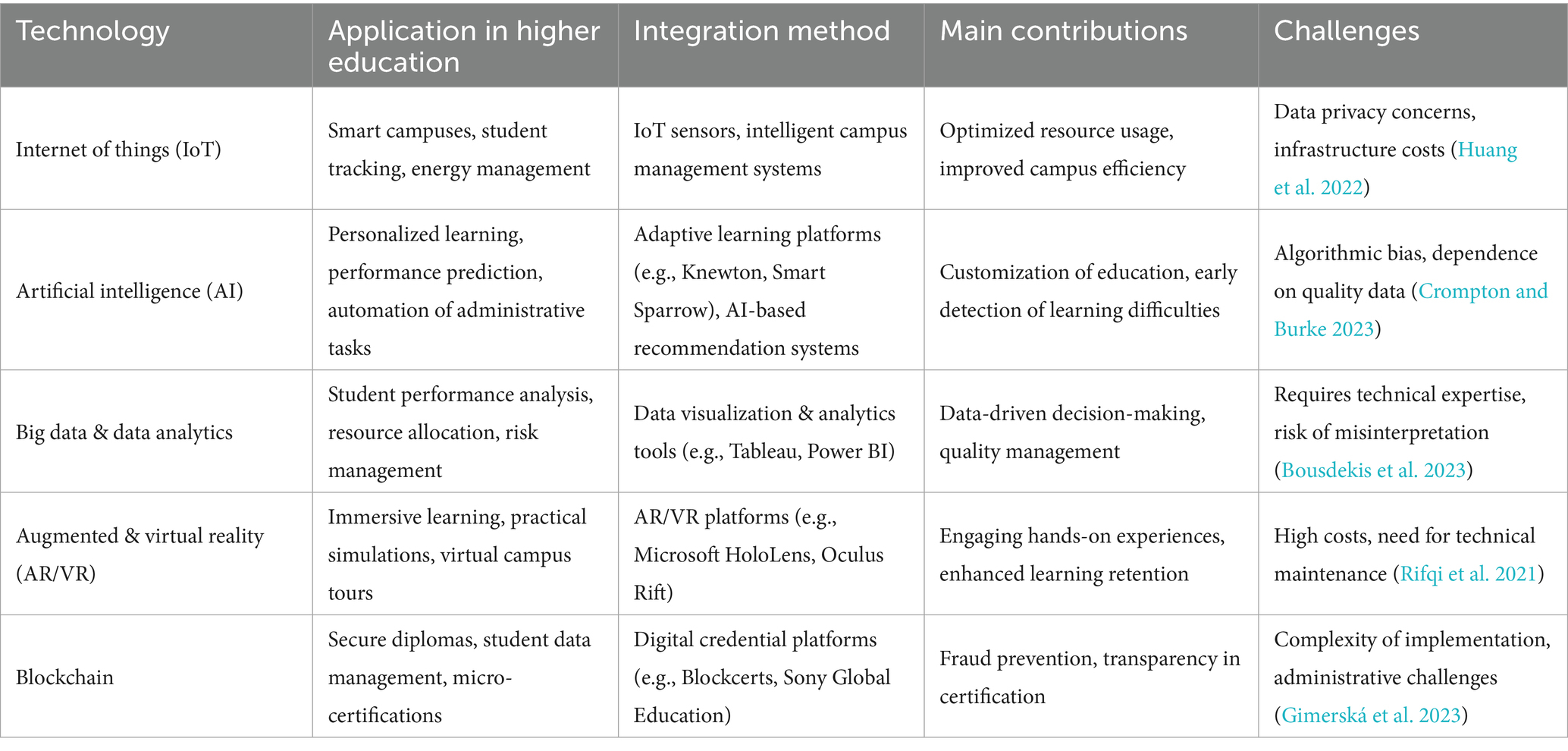
Table 11. Industry 4.0 technologies be integrated into HE institutions to improve the quality of education.
4.2.3.1 The HEQ4.0 model
Despite the growing importance of digitalization and Industry 4.0 technologies in higher education, several limitations persist in current research on educational quality. On the one hand, traditional quality management models do not sufficiently take into account the integration of advanced digital technologies, such as artificial intelligence, the Internet of Things, and the automation of pedagogical processes, which are profoundly transforming teaching and learning practices (Ülker and Otrar, 2024; Gadre and Deoskar, 2024). On the other hand, there is a lack of suitable conceptual and methodological frameworks for assessing and managing quality in highly interconnected and innovative university environments. Moreover, existing approaches often neglect the collaborative and interdisciplinary dimensions that are essential for universities to function as complex ecosystems. Finally, quality management struggles to reflect the rapid changes in expected skills and to systematically integrate stakeholder needs into the continuous improvement process (Chernaya et al., 2023).
In light of these findings, we propose the HEQ4.0 (Higher Education Quality 4.0) model (Figure 4), which provides a conceptual and operational framework to support institutions in their digital transformation. This model addresses the methodological and conceptual gaps identified in the literature by articulating technological, organizational, pedagogical, and behavioral dimensions. It aims to strengthen student engagement, administrative efficiency, and pedagogical innovation, while facilitating the simultaneous consideration of digital innovations, stakeholder expectations, and skills development imperatives. Designed as an integrated and progressive approach, the HEQ4.0 model provides a solid foundation to guide the practical implementation of Quality 4.0 in higher education.
4.2.3.1.1 Data inputs
This section brings together data collected in real time from academic systems such as LMS platforms, student information systems and IoT sensors, with the aim of feeding decision-making analyses. Despite this, the quality of this data can vary in terms of accuracy, consistency and completeness; it can also be fragmented, poorly structured or non-compliant with RGPD requirements. To overcome these limitations, it is recommended to implement cleansing and validation processes, use data profiling tools to identify anomalies, assess the infrastructure’s capacity to handle massive volumes of data, and apply strict encryption and access management protocols. These considerations are developed in the framework proposed by Alotaibi (2024), which highlights the importance of rigorous data governance in higher education in the Quality 4.0 era.
4.2.3.1.2 Ethic envelope
The ethical envelope provides a framework for the use of technology and data in HE, based on fundamental principles such as algorithmic transparency, fairness, respect for digital rights and the conduct of regular audits. However, this dimension raises several challenges, not least the difficulty of defining algorithmic fairness in an operational way and making systems transparent enough to be understood by all users. In addition, ethical audits can entail significant costs. To meet these challenges, several measures would be recommended, such as setting up multidisciplinary ethics committees, drawing up and distributing a digital ethics charter, implementing indicators for detecting bias and fairness in algorithmic systems, and carrying out regular internal and external audits. In this respect, the recent work of Fowler (2023), emphasizes these recommendations by examining the integration of ethics in AI applied to higher education [AI and Ethics in HE, as well as the work of Holmes et al. (2022)], who propose a multidisciplinary framework for tackling the ethical issues linked to AI in education.
4.2.3.1.3 Technological tools
The third part represents the technological layer of our HEQ4.0 model. It integrates various advanced solutions, such as AI and machine learning for path personalization, IoT for real-time information feedback, blockchain to ensure data traceability and authenticity, and cloud computing to guarantee infrastructure scalability. However, the implementation of these technologies poses a number of challenges, including the complexity of integrating them into heterogeneous environments, the initial cost of investment, the lack of in-house skills to ensure their optimal operation, as well as increased cybersecurity risks. To mitigate these limitations, it would be advisable to carry out performance tests (particularly in terms of response time and scalability), conduct regular security audits and penetration tests, develop targeted training plans for in-house teams, and carry out a rigorous cost/benefit analysis of the technological tools deployed. These issues and solutions are extensively analyzed in the work of Islam (2023), who explores the opportunities and challenges associated with the joint use of AI and blockchain in smart education systems, as well as in the study by Divya et al. (2024), which proposes a systemic architecture to govern the integration of AI in higher education.
4.2.3.1.4 Operational practices
This component of the HEQ4.0 model focuses on concrete uses of technology in HE institutions, such as predictive analysis of dropouts, use of digital twins to simulate learning environments, automation of repetitive tasks and implementation of real-time feedback mechanisms. Nevertheless, the implementation of these practices raises several obstacles, including resistance to change on the part of institutional players, the need to rethink and adapt existing organizational processes, the high costs involved in developing and maintaining digital twins, and the potential risk of dehumanizing pedagogical interactions. To effectively support this transformation, it is essential to define operational performance indicators (KPIs) such as processing time reduction or prediction accuracy, carry out user satisfaction surveys, conduct impact studies on organizational structures, and test innovations through pilot projects. In this context, (Katsamakas et al., 2024), support these orientations by examining AI-driven decision support systems in universities, as well as by Alotaibi (2024), who proposes a quality 4.0 framework adapted to higher education integrating.
4.2.3.1.5 Strategic results
This part of the model aims to produce concrete strategic outcomes such as increased student engagement, enhanced administrative efficiency and ongoing pedagogical innovation. However, measuring the real impact of these transformations can prove complex, as the expected effects are often gradual and deferred in time. This temporality makes it difficult to assess the benefits immediately and comprehensively. To overcome this difficulty, a number of monitoring indicators can be put in place, including student retention, attendance and success rates, efficiency indicators such as the reduction of errors or processing times, as well as the monitoring of the adoption of new pedagogical approaches and their measured effects on learning. To this end, these elements are in line with (Wawak et al., 2024), who emphasize, in a Triple Helix perspective, the central role of Quality 4.0 in the sustainable improvement of education and cooperation between universities, industries and governments.
4.2.3.1.6 Outputs
The final section is devoted to model outputs, which represent the concrete deliverables generated by the HEQ4.0 model, including interactive dashboards, intelligent alert systems and personalized recommendations derived from the analysis of educational data. These tools are designed to facilitate decision-making and improve institutions’ responsiveness to student needs and organizational changes. However, their usefulness can be compromised if there is information overload, or if the recommendations generated are not sufficiently contextualized or exploitable by end-users. Thus, to guarantee the effectiveness of these systems, it would be wise to evaluate the relevance of the visualizations proposed according to user profiles (students, teachers, managers), to measure responsiveness to alerts issued, and to systematically monitor the implementation and impact of the recommendations made. These considerations are analyzed in the article by Islam (2023), which explores the synergies between AI and blockchain in smart education systems, with an emphasis on the conditions of usability and impact of these digital tools.
• Theoretical and practical contributions of the HEQ4.0 model
Our proposed model introduces an integrated conceptual framework built around six interdependent components: data, ethical envelope, technological tools, operational practices, strategic outcomes and outputs. This structuring enables the digital transformation of quality in higher education to be approached in a comprehensive, coherent and systemic way. The model links complementary disciplinary fields such as QM, AI, digital ethics and data governance, bridging the gap between traditional approaches to quality assurance and the emerging requirements of digitalization. In addition, with the integration of an explicit ethical dimension, the model also enriches current thinking on transparency, fairness and accountability in the use of educational technologies.
In practical terms, the model serves as a strategic steering tool, offering establishments a grid for analyzing their digital maturity and a set of concrete levers for supporting their transformation. It proposes specific assessment measures for each component, thus encouraging gradual implementation, often initiated by pilot projects. It also helps to anticipate the risks associated with technological integration, particularly in terms of cybersecurity, information overload and the dehumanization of interactions. In addition, the model supports pedagogical innovation and student engagement by promoting the use of advanced technologies such as AI, digital twins or predictive analytics. It also facilitates interoperability between digital systems (LMS, IoT, blockchain, cloud), reinforcing the coherence and agility of educational infrastructures.
However, it should be stressed that HEQ4.0 is based, in part, on an idealized model of how institutions operate. In practice, many institutions lack the technological resources, organizational flexibility and governance necessary to achieve this level of integration. The education system is characterized by high complexity, fragmented structures and often rigid institutional dynamics, making uniform implementation difficult. Consequently, HEQ4.0 should not be interpreted as a standardized model, but as an adaptable framework, to be contextualized according to the specificities, constraints and capabilities of each establishment. This flexibility of application makes the model a relevant tool for supporting the diversity of transformation trajectories in HE.
5 Conclusion
This study is based on a systematic review of 32 articles from the Scopus and Web of Science databases, analyzed in depth to explore the integration of Industry 4.0 technologies in higher education institutions and their impact on improving educational quality management. The results reveal that technologies such as artificial intelligence, big data, augmented reality and blockchain can transform quality management practices by personalizing learning, optimizing resources and ensuring data security. However, their implementation raises several challenges, including high costs, data protection issues and the need to train academic actors in these new tools. To address these challenges and support institutions in their transition to an educational model focused on Quality 4.0, we propose the HEQ4.0 model. This model offers a global and operational vision of the integration of 4.0 technologies in higher education, allowing institutions to assess and improve their digital maturity. It also serves as a guide for a progressive and controlled transformation, integrating ethical, organizational and technological aspects. Recommendations from this study include investing in interoperable infrastructures, continuous training of staff, the implementation of strict data protection policies and the development of strategic partnerships with technological and institutional actors. In addition, efforts must be devoted to raising awareness of the ethical issues related to AI and the exploitation of academic data in order to ensure a responsible and transparent integration of digital innovations. Finally, this research opens future perspectives by suggesting to deepen the analysis of the long-term impacts of emerging technologies on higher education and to explore strategies to overcome the obstacles to their adoption. In short, Industry 4.0 technologies represent a major opportunity to revolutionize higher education, but their integration requires a strategic, progressive and ethical approach in order to ensure sustainable and equitable results for all academic actors.
Data availability statement
The original contributions presented in the study are included in the article/supplementary material, further inquiries can be directed to the corresponding author.
Author contributions
FAb: Supervision, Methodology, Conceptualization, Software, Investigation, Writing – original draft, Funding acquisition, Project administration, Formal analysis, Visualization, Validation, Resources, Data curation, Writing – review & editing. SA: Supervision, Validation, Writing – original draft, Resources. KM: Supervision, Methodology, Writing – original draft, Validation. FAk: Writing – review & editing, Supervision.
Funding
The author(s) declare that no financial support was received for the research and/or publication of this article.
Conflict of interest
The authors declare that the research was conducted in the absence of any commercial or financial relationships that could be construed as a potential conflict of interest.
Generative AI statement
The authors declare that no Gen AI was used in the creation of this manuscript.
Any alternative text (alt text) provided alongside figures in this article has been generated by Frontiers with the support of artificial intelligence and reasonable efforts have been made to ensure accuracy, including review by the authors wherever possible. If you identify any issues, please contact us.
Publisher’s note
All claims expressed in this article are solely those of the authors and do not necessarily represent those of their affiliated organizations, or those of the publisher, the editors and the reviewers. Any product that may be evaluated in this article, or claim that may be made by its manufacturer, is not guaranteed or endorsed by the publisher.
References
Alotaibi, N. S. (2024). The impact of AI and LMS integration on the future of higher education: opportunities, challenges, and strategies for transformation. Sustainability 16:10357. doi: 10.3390/su162310357
Al-Tarawneh, D. H. A. (2011). The implementation of total quality management (TQM) on the higher educational sector in Jordan. Int. J. Industrial Marketing 1. doi: 10.5296/ijim.v1i1.771
Alzahrani, B., Bahaitham, H., Andejany, M., and Elshennawy, A. (2021). How ready is higher education for quality 4.0 transformation according to the LNS research framework? Sustainability 13:5169. doi: 10.3390/su13095169
Amir-Behghadami, M., and Janati, A. (2020). Population, intervention, comparison, outcomes and study (PICOS) design as a framework to formulate eligibility criteria in systematic reviews. Emerg. Med. J. 37, 387. doi: 10.1136/emermed-2020-209567
Antonino, P. O., Capilla, R., Pelliccione, P., Schnicke, F., Espen, D., Kuhn, T., et al. (2022). A quality 4.0 model for architecting industry 4.0 systems. Adv. Eng. Inform. 54, 6–10. doi: 10.1016/j.aei.2022.101801
Antony, J., Kaul, A., Bhat, S., Sony, M., Kaul, V., Zulfiqar, M., et al. (2024). Critical failure factors for quality 4.0: an exploratory qualitative study. Int. J. Qual. Reliab. Manag. 41, 1044–1062. doi: 10.1108/IJQRM-07-2023-0240
Barsalou, M. (2023) « Root cause analysis in quality 4.0: a scoping review of current state and perspectives », TEM J., 12, p. 73–79. Disponible sur: Doi:doi: 10.18421/TEM121-10
Baygin, M, Yetis, H, Karakose, M, and Akin, E (2016) « An effect analysis of industry 4.0 to higher education », in 2016 15th International Conference on Information Technology Based Higher Education and Training (ITHET). 2016 15th International Conference on Information Technology Based Higher Education and Training (ITHET), p. 1–4.
Bearman, M., Ryan, J., and Ajjawi, R. (2023). Discourses of artificial intelligence in higher education: a critical literature review. Higher Educ. 86, 369–385. doi: 10.1007/s10734-022-00937-2
Bond, M., Khosravi, H., De Laat, M., Bergdahl, N., Negrea, V., Oxley, E., et al. (2024). A meta systematic review of artificial intelligence in higher education: a call for increased ethics, collaboration, and rigour. Int. J. Educ. Technol. High. Educ. 21:4. doi: 10.1186/s41239-023-00436-z
Bousdekis, A., Lepenioti, K., Apostolou, D., and Mentzas, G. (2023). Data analytics in quality 4.0: literature review and future research directions. Int. J. Comput. Integr. Manuf. 36, 678–701. doi: 10.1080/0951192X.2022.2128219
Broday, E. E. (2022). The evolution of quality: from inspection to quality 4.0. Int. J. Qual. Serv. Sci. 14, 368–382. doi: 10.1108/IJQSS-09-2021-0121
Carvalho, A. M., Dias, A. R., Dias, A. M., and Sampaio, P. (2024). The quality 4.0 roadmap: designing a capability roadmap toward quality management in industry 4.0. Qual. Manag. J. 31, 117–137. doi: 10.1080/10686967.2024.2317478
Carvalho, A. V., and Lima, T. M. (2022). Quality 4.0 and cognitive engineering applied to quality management systems: a framework. Appl. Syst. Innov. 5, 7–10. doi: 10.3390/asi5060115
Chakraborty, S., and Galatro, D. (2025). Incorporating agile methodologies into the chemical engineering curriculum. Comput. Appl. Eng. Educ. 33:e22805. doi: 10.1002/cae.22805
Chakraborty, S., Gonzalez-Triana, Y., Mendoza, J., and Galatro, D. (2023). Insights on mapping industry 4.0 and education 4.0. Front. Educ. 8:233. doi: 10.3389/feduc.2023.1150190
Chakraborty, S., and Sertu, B.B. et Galatro, D. (2025) « Artificial intelligence (AI), sustainability and engineering education: implementation trends in STEM to realize society 5.0. », Proc. Canadian Eng. Educ. Assoc. [Preprint]. doi: 10.24908/pceea.2025.19678
Chernaya, I. P., Masyuk, N. N., Prosalova, V. S., Bodunkova, A. G., and Bushueva, M. A. (2023). University 4.0 concept: educational and scientific policies, innovative development of vocational education and training. Front. Educ. 8:1125361. doi: 10.3389/feduc.2023.1125361
Chiarini, A., and Kumar, M. (2022). What is quality 4.0? An exploratory sequential mixed methods study of Italian manufacturing companies. Int. J. Prod. Res. 60, 4890–4910. doi: 10.1080/00207543.2021.1942285
Crompton, H., and Burke, D. (2023) « Artificial intelligence in higher education: the state of the field », Int. J. Educ. Technol. High. Educ., 20, p. 1–22. Disponible sur: Doi:doi: 10.1186/s41239-023-00392-8
Oliveira, Leonam Cordeirode, Guerino, Guilherme Corredato, Oliveira, Leander Cordeirode, and Pimentel, Andrey Ricardo. (2023). Information and communication technologies in education 4.0 paradigm: a systematic mapping study Inform. Educ. 22 71–98
Divya, Teja MH, Reddy, KV, Kumar, K, and Lean, Sharma R. (2024) « Lean six sigma applicability for higher educational institutes », in. AIP Conference Proceedings.
Efimova, A., and Briš, P. (2021). Quality 4.0 for processes and customers. Qual. Innov. Prosper. 25, 33–47. doi: 10.12776/qip.v25i3.1609
Elshennawy, A. K. (2004). Quality in the new age and the body of knowledge for quality engineers. Total Qual. Manag. Bus. Excel. 15, 603–614. doi: 10.1080/14783360410001680099
Escobar, C.A., and McGovern, M.E. et Morales-Menendez, R. (2021) « Quality 4.0: a review of big data challenges in manufacturing », J. Intell. Manuf., 32:2375. Disponible sur: Doi:doi: 10.1007/s10845-021-01786-z
Fonseca, L., Amaral, A., and Oliveira, J. (2021). Quality 4.0: the EFQM 2020 model and industry 4.0 relationships and implications. Sustainability 13:3107. doi: 10.3390/su13063107
Fowler, D.S. (2023). Ai in higher education: academic integrity, harmony of insights, and recommendations. J. Ethics High. Educ. 127–143. doi: 10.26034/fr.jehe.2023.4657
Gadre, M., and Deoskar, A. (2024). Navigating the challenges and strategies for higher education institutions in mapping industry 4.0 based education: a PLS-SEM analysis. Acad. Strateg. Manage. J. 23, 1–10.
Galatro, D. et Chakraborty, S.. (2025) « Strategies to map education 5.0 and industry 5.0 in the context of a modernized undergraduate program in chemical engineering », in 2025 IEEE Global Engineering Education Conference (EDUCON). 2025 IEEE Global Engineering Education Conference (EDUCON), p. 1–9.
Galatro, D., and Nardo, A.D. et Chakraborty, S. (2025) « Roadmap to education 5.0: the lab case for heat and mass transfer », Proc. Canadian Eng. Educ. Assoc. [Preprint]. Disponible sur: doi: 10.24908/pceea.2025.19702
Gimerská, V., Šoltés, M., and Mirdala, R. (2023). Improving operational efficiency through quality 4.0 tool: blockchain implementation and subsequent market reaction. Qual. Innov. Pros. 27, 16–32. doi: 10.12776/QIP.V27I2.1877
Harvey, L. (1998). An assessment of past and current approaches to quality in higher education. Aust. J. Educ. 42, 237–255. doi: 10.1177/000494419804200303
Harvey, L., and Green, D. (1993). Defining quality. Assess. Eval. High. Educ. 18, 9–34. doi: 10.1080/0260293930180102
Hinojo-Lucena, F.-J., Aznar-Díaz, I., Cáceres-Reche, M.-P., and Romero-Rodríguez, J.-M. (2019). Artificial intelligence in higher education: a bibliometric study on its impact in the scientific literature. Educ. Sci. 9:51. doi: 10.3390/educsci9010051
Holmes, W., Porayska-Pomsta, K., Holstein, K., Sutherland, E., Baker, T., Shum, S. B., et al. (2022). Ethics of AI in education: towards a community-wide framework. Int. J. Artif. Intell. Educ. 32, 504–526. doi: 10.1007/s40593-021-00239-1
Huang, Z., Shahzadi, A., and Khan, Y. D. (2022). Unfolding the impact of quality 4.0 practices on industry 4.0 and circular economy practices: a hybrid SEM-ANN approach. Sustainability 14:15495. doi: 10.3390/su142315495
Islam, M.A. (2023) « AI & Blockchain as sustainable teaching and learning tools to cope with the 4IR ». arXiv Disponible sur: Doi:doi: 10.48550/arXiv.2305.01088
Ivanov, S. (2023). The dark side of artificial intelligence in higher education. Serv. Ind. J. 43, 1055–1082. doi: 10.1080/02642069.2023.2258799
Katsamakas, E., and Pavlov, O.V. et Saklad, R. (2024) « Artificial intelligence and the transformation of higher education institutions ». arXiv Disponible sur: Doi:doi: 10.48550/arXiv.2402.08143
Kerroum, K., Khiat, A., Bahnasse, A., Aoula, E.-S., and khiat, Y. (2020). The proposal of an agile model for the digital transformation of the university Hassan II of Casablanca 4.0. Procedia Comput. Sci. 175, 403–410. doi: 10.1016/j.procs.2020.07.057
Kitchenham, B. (2007) Guidelines for performing systematic literature reviews in software engineering. EBSE Technical Report. Available online at: https://docs.opendeved.net/lib/7RP54LK8 (Consulté le: 21 juillet 2025).
Liu, H.-C., Liu, R., Gu, X., and Yang, M. (2023). From total quality management to quality 4.0: a systematic literature review and future research agenda. Front. Eng. Manag. 10, 191–205. doi: 10.1007/s42524-022-0243-z
Lo, N., Wong, A., and Chan, S. (2025). The impact of generative AI on essay revisions and student engagement. Comput. Educ. Open 9:100249. doi: 10.1016/j.caeo.2025.100249
Miranda, J., Navarrete, C., Noguez, J., Molina-Espinosa, J.-M., Ramírez-Montoya, M.-S., Navarro-Tuch, S. A., et al. (2021). The core components of education 4.0 in higher education: three case studies in engineering education. Comput. Electr. Eng. 93:107278. doi: 10.1016/j.compeleceng.2021.107278
Mtotywa, M. M. (2022). Developing a quality 4.0 maturity index for improved business operational efficiency and performance. Qual. Innov. Prosper. 26, 101–127. doi: 10.12776/qip.v26i2.1718
Nenadál, J. (2020). The new EFQM model: what is really new and could be considered as a suitable tool with respect to quality 4.0 concept? Qual. Innov. Prosper. 24, 17–28. doi: 10.12776/qip.v24i1.1415
Nenadál, J., Vykydal, D., Halfarová, P., and Tylečková, E. (2022). Quality 4.0 maturity assessment in light of the current situation in the Czech Republic. Sustainability 14:7519. doi: 10.3390/su14127519
Pacheco-Mendoza, S., Guevara, C., Mayorga-Albán, A., and Fernández-Escobar, J. (2023). Artificial intelligence in higher education: a predictive model for academic performance. Educ. Sci. 13:990. doi: 10.3390/educsci13100990
Papanthymou, A., and Darra, M. (2017). Quality management in higher education: review and perspectives. High. Educ. Stud. 7, 132–147. doi: 10.5539/hes.v7n3p132
Radziwill, N.M. (2018) « Quality 4.0: let’s get digital - the many ways the fourth industrial revolution is reshaping the way we think about quality ». arXiv Disponible sur: Doi:doi: 10.48550/arXiv.1810.07829
Ramezani, J., and Jassbi, J. (2020). Quality 4.0 in action: smart hybrid fault diagnosis system in plaster production. PRO 8:634. doi: 10.3390/PR8060634
Rifqi, H, Zamma, A, Souda, SB, and Hansali, M (2021) « Positive effect of industry 4.0 on quality and operations management », Int. J. Online Biomed. Eng., 17, p. 133–147. Disponible sur: Doi:doi: 10.3991/ijoe.v17i09.24717
Salimbeni, S., Redchuk, A., and Rousserie, H. (2023). Quality 4.0: technologies and readiness factors in the entire value flow life cycle. Prod. Manuf. Res. 11:2238797. doi: 10.1080/21693277.2023.2238797
Santos, G., Sá, J. C., Félix, M. J., Barreto, L., Carvalho, F., Doiro, M., et al. (2021). New needed quality management skills for quality managers 4.0. Sustainability 13:6149. doi: 10.3390/su13116149
Shea, B. J., Grimshaw, J. M., Wells, G. A., Boers, M., Andersson, N., Hamel, C., et al. (2007). Development of AMSTAR: a measurement tool to assess the methodological quality of systematic reviews. BMC Med. Res. Methodol. 7:10. doi: 10.1186/1471-2288-7-10
Sony, M., Antony, J., and Douglas, J. A. (2020). Essential ingredients for the implementation of quality 4.0: a narrative review of literature and future directions for research. TQM J. 32, 779–793. doi: 10.1108/TQM-12-2019-0275
Sony, M., Antony, J., Douglas, J. A., and McDermott, O. (2021). Motivations, barriers and readiness factors for quality 4.0 implementation: an exploratory study. TQM J. 33, 1502–1515. doi: 10.1108/TQM-11-2020-0272
Stefanovic, M., Wawak, S., Popkova, E., Eric, M., Mitrovic, S., Djordjevic, A., et al. (2024). From quality 4.0 to quality 5.0 - the transition roadmap. Int. J. Qual. Res. 18, 1199–1210. doi: 10.24874/IJQR18.04-18
Ülker, N., and Otrar, M. (2024). University 4.0 essentials: influence of industry 4.0 on higher education. Ind. High. Educ. 39:09504222241295625. doi: 10.1177/09504222241295625
Wawak, S., Teixeira Domingues, J. P., and Sampaio, P. (2024). Quality 4.0 in higher education: reinventing academic-industry-government collaboration during disruptive times. TQM J. 36, 1569–1590. doi: 10.1108/TQM-07-2023-0219
Keywords: quality 4.0, higher education, quality management practices, industry 4.0 technologies, artificial intelligence
Citation: Abnoulgid F, Aouhassi S, Mansouri K and Akef F (2025) Quality 4.0 in higher education: integrating industry 4.0 technologies in higher education quality management practices. Front. Educ. 10:1594377. doi: 10.3389/feduc.2025.1594377
Edited by:
Aurora Dimache, Atlantic Technological University, IrelandReviewed by:
Noble Lo, Lancaster University, United KingdomSourojeet Chakraborty, University of Toronto, Canada
Copyright © 2025 Abnoulgid, Aouhassi, Mansouri and Akef. This is an open-access article distributed under the terms of the Creative Commons Attribution License (CC BY). The use, distribution or reproduction in other forums is permitted, provided the original author(s) and the copyright owner(s) are credited and that the original publication in this journal is cited, in accordance with accepted academic practice. No use, distribution or reproduction is permitted which does not comply with these terms.
*Correspondence: Fatima Abnoulgid, ZmF0aW1hLmFibm91bGdpZC1ldHVAZXR1LnVuaXZoMmMubWE=
 Fatima Abnoulgid
Fatima Abnoulgid Sarah Aouhassi
Sarah Aouhassi Khalifa Mansouri
Khalifa Mansouri